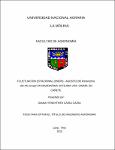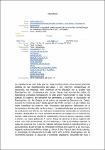Mostrar el registro sencillo del ítem
Fluctuación estacional (enero-agosto) de Panonychus citri McGregor en mandarina Satsuma var. Owari, en Cañete
| dc.contributor.advisor | Castillo Valiente, Jorge Ramón | |
| dc.contributor.author | Caira Caira, Diana Yennyfher | |
| dc.date.accessioned | 2016-10-25T14:20:01Z | |
| dc.date.available | 2016-10-25T14:20:01Z | |
| dc.date.issued | 2015 | |
| dc.identifier.other | H10.C357-T BAN UNALM | |
| dc.identifier.uri | https://hdl.handle.net/20.500.12996/1944 | |
| dc.description | Universidad Nacional Agraria La Molina. Facultad de Agronomía. Departamento Académico de Entomología | es_PE |
| dc.description.abstract | La mandarina es una fruta que se viene constituyendo en el nuevo producto estrella de las exportaciones peruanas y con enormes perspectivas de desarrollo, sin embargo este potencial se ve afectado por la arañita roja Panonychus citri, considerada una de las plagas más nocivas del cultivo de Mandarina, elevadas infestaciones de éste ácaro hacen perder el vigor de las plantas. El objetivo del presente fue determinar y analizar la fluctuación de Panonychus citri Mc Gregor en el cultivo de mandarina Satsuma var. Owari, durante los meses de enero hasta agosto del 2012, en San Luis de Cañete, así como identificar los factores más relevantes que podrían influenciar en el incremento o disminución de dicho ácaro. La metodología que se propuso fue la de evaluación por hileras, se realizaron evaluaciones semanales en veinticinco árboles, distribuidos en cinco sectores paralelos en campo (cinco árboles por sector), cada planta se dividió en cuadrantes y éstos en tercios: superior, medio e inferior. La mayor población P. citri en hojas se ubicó en el tercio superior del árbol, con 3.82 adultos/hoja, 3.63 ninfas/hoja y 4.94 posturas/hoja durante la etapa de cosecha. En frutos los valores máximos fueron 5 individuos/fruto y 6 posturas/fruto. El porcentaje de infestación en hojas fue superior al de los frutos, llegando a alcanzar el 49% en hojas y 10% en frutos. Para el caso de las plantas, el porcentaje de infestación fluctuaba entre 28% a 90%. Panonychus citri se incrementó durante la etapa de crecimiento vegetativo, desarrollo de fruto y cosecha con una temperatura que oscilaba entre los 23° a 25 °C, y humedad relativa de 70% a 80%. Las labores culturales como el riego y el lavado de plantas constituyeron una buena alternativa dentro del Manejo Integrado para P. citri. | es_PE |
| dc.description.abstract | The Tangerine is a fruit that is fast becoming the new flagship product of Peruvian exports and huge development prospects, however this potential is affected by the red mite Panonychus citri, considered one of the most destructive crop pests Tangerine , high mite infestations do lose this plant vigor. The aim of this was to determine and analyze the fluctuation of Panonychus citri Mc Gregor in Satsuma mandarin cultivation var. Owari, during the months of January to August 2012, in San Luis de Cañete and identify the most important factors that could influence the increase or decrease of the mite. The methodology proposed was the assessment by rows, weekly evaluations were performed in twenty trees, distributed in five parallel sectors in the field (five trees per sector), each floor is divided into quadrants and these into thirds: superior, middle and lower . The population P. citri in leaves are placed in the upper third of the tree, with 3.82 adults / leaf , 3.63 nymphs / leaf and 4.94 eggs/ sheet during the harvest stage. In off peak values were 5 mite / fruit and 6 eggs / fruit. The percentage of infestation in leaves was higher than the rewards, reaching 49% in leaves and 10% in fruits. In the case of plants, the percentage of infestation ranged from 28% to 90%. Panonychus citri increased during the vegetative stage of growth, development and harvesting of fruit with a temperature ranging between 23 ° to 25 ° C, and relative humidity of 70% to 80%. Cultural practices such as irrigation and washing floors were a good alternative in the Integrated Management for P. citri. | es_PE |
| dc.format | application/pdf | es_PE |
| dc.language.iso | spa | es_PE |
| dc.publisher | Universidad Nacional Agraria La Molina | es_PE |
| dc.rights | info:eu-repo/semantics/openAccess | es_PE |
| dc.rights.uri | https://creativecommons.org/licenses/by-nc-nd/4.0/ | es_PE |
| dc.subject | Citrus reticulata | es_PE |
| dc.subject | Satsuma | es_PE |
| dc.subject | Variedades | es_PE |
| dc.subject | Panonychus citris | es_PE |
| dc.subject | Periodicidad | es_PE |
| dc.subject | Evaluación | es_PE |
| dc.subject | Control de plagas | es_PE |
| dc.subject | Perú | es_PE |
| dc.subject | Mandarina satsuma owari | es_PE |
| dc.subject | Fluctuación estacional | es_PE |
| dc.subject | Lima (dpto) | es_PE |
| dc.subject | Cañete (prov) | es_PE |
| dc.subject | Arañas roja | es_PE |
| dc.title | Fluctuación estacional (enero-agosto) de Panonychus citri McGregor en mandarina Satsuma var. Owari, en Cañete | es_PE |
| dc.type | info:eu-repo/semantics/bachelorThesis | es_PE |
| thesis.degree.discipline | Agronomía | es_PE |
| thesis.degree.grantor | Universidad Nacional Agraria La Molina. Facultad de Agronomía | es_PE |
| thesis.degree.name | Ingeniero Agrónomo | es_PE |
| dc.subject.ocde | http://purl.org/pe-repo/ocde/ford#4.01.06 | es_PE |
| renati.author.dni | 44469145 | es_PE |
| dc.publisher.country | PE | es_PE |
| dc.type.version | info:eu-repo/semantics/publishedVersion | es_PE |
| renati.advisor.orcid | https://orcid.org/0000-0003-3561-2253 | es_PE |
| renati.advisor.dni | 16450605 | es_PE |
| renati.type | https://purl.org/pe-repo/renati/type#tesis | es_PE |
| renati.level | https://purl.org/pe-repo/renati/level#tituloProfesional | es_PE |
| renati.discipline | 811036 | es_PE |
| renati.juror | Escobedo Álvarez, Jorge Alberto | |
| renati.juror | Narrea Cango, Mónica | |
| renati.juror | Rodríguez Berrío, Alexander Régulo |
Ficheros en el ítem
Este ítem aparece en la(s) siguiente(s) colección(ones)
-
AGR-EN Tesis [99]




